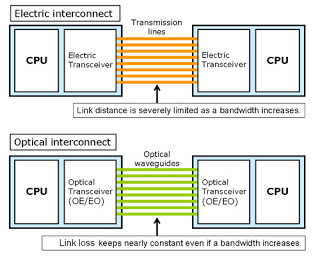Fujitsu Laboratories Limited today announced the development of a compact silicon photonics light source for use in optical transceivers required for optical interconnects capable of carrying large volumes of data at high speeds between CPUs. This will ermits smaller transmitters in optical transceivers, obviates need for thermal control mechanism, marking a step towards high-bandwidth optical interconnects. This technology enables compact, low-power optical transceivers to be mounted directly in CPU packaging. Through its application to optical interconnects between CPUs for exaflops-class supercomputers and high-end servers, the technology paves the way for super-high-speed computers.
In the past, when the silicon photonics light sources built into optical transceivers, and the optical modulators that encode data into the light emitted from the light source experienced thermal fluctuations, a mismatch between the lasing wavelength of the light source and the operating wavelength of the modulator could arise, causing concern that the light would not carry information. This is why thermal control has become indispensable as a way to maintain operating wavelengths that consistently match. By introducing a mechanism that automatically keeps the light source’s wavelength and the modulator’s operating wavelength in sync, Fujitsu Laboratories has obviated the need for a thermal control mechanism, allowing for the device to be smaller and more energy efficient.
Figure 1. High-capacity interconnect technologies
About the Newly-Developed Technology
Fujitsu Laboratories has developed the world’s first compact silicon photonics light source that obviates the need for a thermal control mechanism. The light source is composed of a silicon mirror and a semiconductor optical amplifier (see red box, Figure 3). The silicon mirror, in turn, comprises a ring resonator and Bragg reflector (see blue box, Figure 3), controlling the lasing wavelength.
The sizes of the ring resonators introduced into both the light source and the optical modulator are exactly the same, so that shifts in the light source’s lasing wavelength and the optical modulator’s operating wavelength caused by CPU heat should match. This obviates the use in the thermal control mechanism that is otherwise required by the existing technology, enabling the optical transceiver to be made more compact and energy efficient. The transmitter component can be shrunk to less than 1 mm in length. Arraying these in a row should realize an optical transceiver for a large-capacity optical interconnect that is small enough to be mounted on a CPU module.
Figure 3. Transmitter component of the silicon-photonics optical transceiver
Figure 2. Optical transceiver in CPU module
Results
This technology is a stepping stone toward the future of exaflops-class supercomputers and high-end servers that use large-capacity optical interconnects on a large scale and with low energy requirements.
Future Plans
Fujitsu Laboratories plans to continue the development of optical transceivers for large-capacity interconnects by integrating this light source technology.
If you liked this article, please give it a quick review on ycombinator or StumbleUpon. Thanks

Brian Wang is a Futurist Thought Leader and a popular Science blogger with 1 million readers per month. His blog Nextbigfuture.com is ranked #1 Science News Blog. It covers many disruptive technology and trends including Space, Robotics, Artificial Intelligence, Medicine, Anti-aging Biotechnology, and Nanotechnology.
Known for identifying cutting edge technologies, he is currently a Co-Founder of a startup and fundraiser for high potential early-stage companies. He is the Head of Research for Allocations for deep technology investments and an Angel Investor at Space Angels.
A frequent speaker at corporations, he has been a TEDx speaker, a Singularity University speaker and guest at numerous interviews for radio and podcasts. He is open to public speaking and advising engagements.




